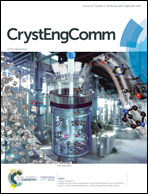Copper dithiolene [Cu(SC6H2Cl2S)2]− units connected to alkaline/copper complexes: from ionic assemblies to discrete molecular entities and coordination polymers†
Abstract
Direct reaction between Cu(ClO4)2 and 3,6-dichloro-1,2-benzenedithiol (HSC6H2Cl2SH) in the presence of basic salts, i.e. NaOH, KOH, Rb2CO3 or Cs2CO3, leads to a series of bis(dithiolato)cuprate(III) [Cu(SC6H2Cl2S)2]− coordination complexes and coordination polymers depending upon the metal counterion used in the process. These compounds clearly show the robustness of the bis(dithiolato)cuprate(III) [Cu(SC6H2Cl2S)2]− entities, showing a nearly planar structure which is retained not only when they interact weakly with alkaline cations but also when they do it with more strongly interacting copper(I) ions. In the latter case, the interaction provides one of the few examples so-far reported on CuI/CuIII mixed oxidation state compounds. This study also shows that the sulfur and chloro donor atoms of the [Cu(SC6H2Cl2S)2]− entity are able to anchor soft-metal cations giving rise to the formation of coordination polymers. A semiconductor behaviour is observed in the polymers {[Rb(OH2)][Cu(SC6H2Cl2S)2]}n and {[Cs(OH2)][Cu(SC6H2Cl2S)2]}n.
![Graphical abstract: Copper dithiolene [Cu(SC6H2Cl2S)2]− units connected to alkaline/copper complexes: from ionic assemblies to discrete molecular entities and coordination polymers](/en/Image/Get?imageInfo.ImageType=GA&imageInfo.ImageIdentifier.ManuscriptID=C8CE01594E&imageInfo.ImageIdentifier.Year=2019)


 Please wait while we load your content...
Please wait while we load your content...